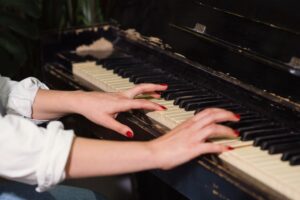 If you have decided to start piano lessons but don’t have a piano in your home, your first step is to figure out what type of instrument you would like to use during the lessons and for practice. Many factors have to be carefully considered, including: price range, instrument condition, space requirements, and your level of commitment to playing the instrument for the long haul.
If you have decided to start piano lessons but don’t have a piano in your home, your first step is to figure out what type of instrument you would like to use during the lessons and for practice. Many factors have to be carefully considered, including: price range, instrument condition, space requirements, and your level of commitment to playing the instrument for the long haul.
The two basic options you have are acoustic pianos and digital pianos (also known as electronic keyboards). But even within these two broad categories, there are lots of variations, and those variations can be daunting.
I hope that the guidelines I offer in this article will make decision process around getting your first piano a bit easier for you.
Acoustic Piano or Digital Piano?
Traditionally, an acoustic piano has been the best option for piano study, primarily because the feel of the instrument (especially the weighting and responsiveness of the keys) is so very important for developing proper technique. However, as technology has advanced, the weighting of the keys on many full-scale (88-key) digital pianos provides virtually the same sensitivity as the acoustic instrument. Nowadays, both acoustic and digital pianos are great options for starting lessons, and both can be easily purchased or rented at affordable prices.
New Acoustic Pianos
To rent or finance a new upright piano (square shaped) from a piano store, you can get a top quality instrument for around $100 a month. Prices for new grand or baby grand pianos can vary quite considerably, depending on brand and size, and range anywhere from the low $100s to several hundred dollars per month.
However, it is easy and reliable to go to a piano store to purchase an instrument, and usually, there are several payment plan options available if you would like to have the acoustic instrument for piano study.
Used Acoustic Pianos
The main issue with used pianos, of course, is their condition.
You might find outrageously cheap acoustic pianos on Craigslist or from individuals who are selling their instruments directly, but these are the ones to consider very carefully before buying. If the piano sounds good to you and has no obvious damage, you may have stumbled upon a steal if it’s being offered at a good price.
However, some problems or potential problems with a used acoustic piano may not be obvious. For this reason, it’s a really good idea to consult a piano technician (tuner) when considering purchasing a used acoustic piano. He or she will be able to detect problems you cannot (for example, a hairline soundboard crack) and can advise you as to whether a particular piano is worth the investment as well as what it would cost to repair any problems.
In my opinion, your best source for a used piano is a reputable piano store that also sells new models. These used pianos have been examined by technicians. And such stores tend to be honest and up front about any problems; after all, they wouldn’t remain reputable for long if they didn’t!
The other advantage to shopping in such is store is that you can weigh both new and used piano options against one another to determine where you can get the better monthly payment deal or total cost. This article explains what it is, and why it is important.
Digital pianos
Digital pianos tend to be the most cost-effective option. At prices starting at around $200, you can get a reliable, touch-sensitive instrument that imitates the feel of an acoustic piano and has the same range of keys. Accessories for digital pianos — like a bench and stand — can usually be obtained for about an additional $50 each (or picked up for less from Craigslist or a yard sale).
If you do decide to start lessons with a digital piano, the instrument can usually last through the first several years of study. Many students and parents prefer to start with the digital option, especially if they are assessing interest level for the instrument.
Space and Time
When it comes to space, digital pianos take up much less room than their acoustic counterparts — plus, they are portable! If you’re not sure you have room for an acoustic piano, or if you want to be able to move your instrument around, digital is definitely the way to go!
Time can be another factor. If you’re in a time-crunch to get an instrument before the start of piano lessons, keep in mind that a digital piano can be ordered online and delivered very quickly. So, if you don’t have time to comparison shop in the bricks and mortar piano stores in your town, you might just want to take advantage of the 24-hour shopping day and 2-day shipping that some online retailers offer.
Go Shopping!
Go shopping, and have fun! Don’t let all the variables and variations confuse you. Keep an open ear and an open mind. Know your budget and keep to it. Considering all the available options nowadays, you should definitely be able to get a reasonably priced electronic keyboard or a great deal on buying or financing an acoustic piano.
Obviously, if you’re already set up with a piano teacher, he or she can help you through the decision process.
Also, if you have any questions, or if you have anything to add to my advice, please feel free to post them as comments below. Either I or one of the other many piano teachers at Lessons In Your Home will be happy weigh in.